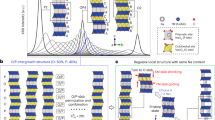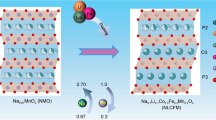Abstract
To power large-scale energy storage systems, sodium-ion batteries (SIBs) must have not only high-energy density but also high performance under a low-temperature (LT) environment. P2-type manganese oxides with high specific capacity are promising cathode candidates for SIBs, but their LT applications are limitedly explored. We proposed a P2-type Na0.67Ni0.1Co0.1Mn0.8O2 material with outstanding LT performance prepared through reasonable structure modulation. The material offers an excellent Na+ diffusion coefficient (approximately 10−9–10−7.5 cm2 s−1) at −20°C, a superior LT discharge capacity of 147.4 mA h g−1 in the Na half-cell system, and outstanding LT full cell performance (energy density of 358.3 W h kg−1). Various characterisations and density function theory calculations results show that the solid solution reaction and pseudocapacitive feature promote the diffusion and desolvation of Na+ from the bulk electrode to interface, finally achieving superior electrochemical performance at LT.

摘要
为实现大规模储能, 钠离子电池不仅需要高的能量密度, 而且需 要在低温环境下依旧发挥出良好的性能. 拥有高比容量的P2锰基氧化 物被认为是钠离子电池中理想的候选正极材料, 但是其低温应用却很 少被探索. 本文通过合理的结构调整, 制备了具有优异低温性能的P2型 Na0.67Ni0.1Co0.1Mn0.8O2正极材料. 该材料表现出了优异的钠离子扩散系 数(~10−9–10−7.5 cm2 s−1, −20°C). 在半电池体系中, 该材料拥有 147.4mA h g−1的低温放电容量. 同样在−20°C条件下, 该电极材料也展 现出能量密度为358.3W h kg−1的出色的全电池性能. 各种表征和密度 泛函理论计算表明固溶反应和赝电容特征促进了钠离子从电极体相到 界面的扩散和脱溶剂化过程, 最终在低温条件下能够获得优异的电化 学性能.
Similar content being viewed by others
References
Hwang JY, Myung ST, Sun YK. Sodium-ion batteries: present and future. Chem Soc Rev, 2017, 46: 3529–3614
Wang X, Roy S, Shi Q, et al. Progress in and application prospects of advanced and cost-effective iron (Fe)-based cathode materials for sodium-ion batteries. J Mater Chem A, 2021, 9: 1938–1969
Wang C, Du D, Song M, et al. A high-power Na3V2(PO4)3-Bi sodium-ion full battery in a wide temperature range. Adv Energy Mater, 2019, 9: 1900022
Wang YY, Hou BH, Guo JZ, et al. An ultralong lifespan and low-temperature workable sodium-ion full battery for stationary energy storage. Adv Energy Mater, 2018, 8: 1703252
Hou BH, Wang YY, Liu DS, et al. N-doped carbon-coated Ni1.8Co1.2Se4 nanoaggregates encapsulated in N-doped carbon nanoboxes as advanced anode with outstanding high-rate and low-temperature performance for sodium-ion half/full batteries. Adv Funct Mater, 2018, 28: 1805444
Zhao N, Zhang F, Zhan F, et al. Fe3+-stabilized Ti3C2T MXene enables ultrastable Li-ion storage at low temperature. J Mater Sci Tech, 2021, 67: 156–164
Hou J, Yang M, Wang D, et al. Fundamentals and challenges of lithium ion batteries at temperatures between −40 and 60 °C. Adv Energy Mater, 2020, 10: 1904152
Gupta A, Manthiram A. Designing advanced lithium-based batteries for low-temperature conditions. Adv Energy Mater, 2020, 10: 2001972
Nian Q, Wang J, Liu S, et al. Aqueous batteries operated at −50 °C. Angew Chem Int Ed, 2019, 58: 16994–16999
Hwang JY, Oh SM, Myung ST, et al. Radially aligned hierarchical columnar structure as a cathode material for high energy density sodium-ion batteries. Nat Commun, 2015, 6: 6865
Li Y, Shi Q, Yin X, et al. Construction nasicon-type NaTi2(PO4)3 nanoshell on the surface of P2-type Na0.67Co0.2Mn0.8O2 cathode for superior room/low-temperature sodium storage. Chem Eng J, 2020, 402: 126181
Yin X, Sarkar S, Shi S, et al. Recent progress in advanced organic electrode materials for sodium-ion batteries: Synthesis, mechanisms, challenges and perspectives. Adv Funct Mater, 2020, 30: 1908445
Shen L, Li Y, Roy S, et al. A robust carbon coating of Na3V2(PO4)3 cathode material for high performance sodium-ion batteries. Chin Chem Lett, 2021, doi: https://doi.org/10.1016/j.cclet.2021.03.005
Dong X, Lin Y, Li P, et al. High-energy rechargeable metallic lithium battery at −70 °C enabled by a cosolvent electrolyte. Angew Chem Int Ed, 2019, 58: 5623–5627
Shen L, Shi S, Roy S, et al. Recent advances and optimization strategies on the electrolytes for hard carbon and P-based sodium-ion batteries. Adv Funct Mater, 2020, 31: 2006066
Jin Y, Xu Y, Le PML, et al. Highly reversible sodium ion batteries enabled by stable electrolyte-electrode interphases. ACS Energy Lett, 2020, 5: 3212–3220
Yue R, Xia F, Qi R, et al. Trace Nb-doped Na0.7Ni0.3Co0.1Mn0.6O2 with suppressed voltage decay and enhanced low temperature performance. Chin Chem Lett, 2021, 32: 849–853
Tie D, Gao G, Xia F, et al. Modulating the interlayer spacing and Na+/vacancy disordering of P2-Na0.67MnO2 for fast diffusion and high-rate sodium storage. ACS Appl Mater Interfaces, 2019, 11: 6978–6985
Dong X, Yang Y, Wang B, et al. Low-temperature charge/discharge of rechargeable battery realized by intercalation pseudocapacitive behavior. Adv Sci, 2020, 7: 2000196
Gao G, Tie D, Ma H, et al. Interface-rich mixed P2 + T phase NaxCo0.1Mn0.9O2 (0.44 ≤ x ≤ 0.7) toward fast and high capacity sodium storage. J Mater Chem A, 2018, 6: 6675–6684
You Y, Yao HR, Xin S, et al. Subzero-temperature cathode for a sodium-ion battery. Adv Mater, 2016, 28: 7243–7248
Rui X, Zhang X, Xu S, et al. A low-temperature sodium-ion full battery: Superb kinetics and cycling stability. Adv Funct Mater, 2020, 31: 2009458
Guo JZ, Wang PF, Wu XL, et al. High-energy/power and low-temperature cathode for sodium-ion batteries: In situ XRD study and superior full-cell performance. Adv Mater, 2017, 29: 1701968
Chen M, Hua W, Xiao J, et al. NASICON-type air-stable and all-climate cathode for sodium-ion batteries with low cost and high-power density. Nat Commun, 2019, 10: 1480
Wang PF, Yao HR, Liu XY, et al. Na+/vacancy disordering promises high-rate Na-ion batteries. Sci Adv, 2018, 4: eaar6018
Hwang J, Kim J, Yu T, et al. A new P2-type layered oxide cathode with extremely high energy density for sodium-ion batteries. Adv Energy Mater, 2019, 9: 1803346
Xiao Y, Zhu Y, Yao H, et al. A stable layered oxide cathode material for high-performance sodium-ion battery. Adv Energy Mater, 2019, 9: 1803978
Wang Y, Xiao R, Hu YS, et al. P2-Na0.6[Cr0.6Ti0.4]O2 cation-disordered electrode for high-rate symmetric rechargeable sodium-ion batteries. Nat Commun, 2015, 6: 6954
Yang Q, Wang PF, Guo JZ, et al. Advanced P2-Na2/3Ni1/3Mn7/12Fe1/12O2 cathode material with suppressed P2–O2 phase transition toward high-performance sodium-ion battery. ACS Appl Mater Interfaces, 2018, 10: 34272–34282
Liang L, Sun X, Denis DK, et al. Ultralong layered NaCrO2 nanowires: A competitive wide-temperature-operating cathode for extraordinary high-rate sodium-ion batteries. ACS Appl Mater Interfaces, 2019, 11: 4037–4046
Augustyn V, Come J, Lowe MA, et al. High-rate electrochemical energy storage through Li+ intercalation pseudocapacitance. Nat Mater, 2013, 12: 518–522
Choi C, Ashby DS, Butts DM, et al. Achieving high energy density and high power density with pseudocapacitive materials. Nat Rev Mater, 2019, 5: 5–19
Laforgue A, Yuan XZ, Platt A, et al. Effects of fast charging at low temperature on a high energy Li-ion battery. J Electrochem Soc, 2020, 167: 140521
Liao B, Li H, Xu M, et al. Designing low impedance interface films simultaneously on anode and cathode for high energy batteries. Adv Energy Mater, 2018, 8: 1800802
Jin T, Wang PF, Wang QC, et al. Realizing complete solid-solution reaction in high sodium content P2-type cathode for high-performance sodium-ion batteries. Angew Chem Int Ed, 2020, 59: 14511–14516
Sun G, Yu FD, Que LF, et al. Local electronic structure modulation enhances operating voltage in Li-rich cathodes. Nano Energy, 2019, 66: 104102
Radin MD, Van der Ven A. Simulating charge, spin, and orbital ordering: Application to Jahn-Teller distortions in layered transition-metal oxides. Chem Mater, 2018, 30: 607–618
Li X, Ma X, Su D, et al. Direct visualization of the Jahn-Teller effect coupled to Na ordering in Na5/8MnO2. Nat Mater, 2014, 13: 586–592
Zhu YF, Xiao Y, Hua WB, et al. Manipulating layered P2@P3 integrated spinel structure evolution for high-performance sodium-ion batteries. Angew Chem Int Ed, 2020, 59: 9299–9304
Wang QC, Meng JK, Yue XY, et al. Tuning P2-structured cathode material by Na-site Mg substitution for Na-ion batteries. J Am Chem Soc, 2019, 141: 840–848
Xiao Y, Wang PF, Yin YX, et al. Exposing {010} active facets by multiple-layer oriented stacking nanosheets for high-performance capacitive sodium-ion oxide cathode. Adv Mater, 2018, 30: 1803765
Ye H, Wang CY, Zuo TT, et al. Realizing a highly stable sodium battery with dendrite-free sodium metal composite anodes and O3-type cathodes. Nano Energy, 2018, 48: 369–376
Zhou K, Xie Q, Li B, et al. An in-depth understanding of the effect of aluminum doping in high-nickel cathodes for lithium-ion batteries. Energy Storage Mater, 2021, 34: 229–240
Mu L, Xu S, Li Y, et al. Prototype sodium-ion batteries using an air-stable and Co/Ni-free O3-layered metal oxide cathode. Adv Mater, 2015, 27: 6928–6933
Acknowledgements
We thank the financial support from the National Natural Science Foundation of China (51774251), Shanghai Science and Technology Commission’s “2020 Science and Technology Innovation Action Plan” (20511104003), the Natural Science Foundation of Shanghai (21ZR1424200), Hebei Natural Science Foundation for Distinguished Young Scholars (B2017203313), and Talent Engineering Training Funds of Hebei Province (A201802001).
Author information
Authors and Affiliations
Contributions
Author contributions Zhao Y, Wang J, Hou Y and Zhang J designed and guided the work. Li Y performed the experiments. Feng X and Wang J performed the first-principles calculations. Li Y wrote the paper with support from Wang X and Shi Q. All authors contributed to the general discussion.
Corresponding authors
Ethics declarations
Conflict of interest The authors declare no conflict of interest.
Additional information
Supplementary information Supporting data are available in the online version of the paper.
Yong Li is a PhD student of Xi’an University of Architecture and Technology under the supervision of Prof. Juan Wang. Currently, he is studying at Shanghai University as an exchange student in Prof. Yufeng Zhao’s group. His research is mainly focused on the low-temperature sodium ion batteries.
Yufeng Zhao is currently working as a professor at Shanghai University. She obtained her PhD from Nanyang Technological University, Singapore in 2006. Afterward, she worked at Deakin University, Australia (2006–2008) and Phillips University Marburg, Germany (2008–2009) as a research scientist. She was also a visiting professor at the Northwestern University (2014–2015). Her research mainly focuses on energy-storage materials and devices, such as nanocarbon materials, supercapacitors, and electro-catalysts.
Juan Wang is currently working as a professor at Xi’an University of Architecture and Technology. She obtained her PhD from Xi’an University of Architecture and Technology in 2009. Afterward, she worked as a visiting research fellow at Georgia Institute of Technology (2013–2014). Her research interests focus on energy storage materials for power sources, including Li-S battery and Li/Na-ion battery.
Yanglong Hou earned his PhD in materials science from Harbin Institute of Technology in 2000. After a short postdoctoral training at Peking University, he worked at the University of Tokyo (2002–2005) as a JSPS foreign special researcher and also at Brown University (2005–2007) as a postdoctoral researcher. He joined Peking University in 2007. His research interests include the design and chemical synthesis of functional nanoparticles, and their biomedical and energy-related applications.
Rights and permissions
About this article
Cite this article
Li, Y., Zhao, Y., Feng, X. et al. A durable P2-type layered oxide cathode with superior low-temperature performance for sodium-ion batteries. Sci. China Mater. 65, 328–336 (2022). https://doi.org/10.1007/s40843-021-1742-8
Received:
Accepted:
Published:
Issue Date:
DOI: https://doi.org/10.1007/s40843-021-1742-8




